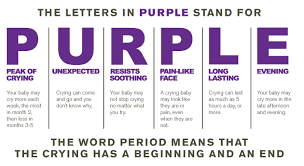For normal, healthy infants crying is a very common occurrence, especially during the first 12 weeks of life. Between 2 and 6 weeks of age a baby’s crying steadily increases and can put a lot of strain on parents, making you feel stress, anxious, angry, upset or just helpless. All babies do go through this period of crying and it can vary in intensity. Much like height or weight, some babies are taller or heavier while others are shorter, some babies cry a great deal, others not so much.

The Period of PURPLE Crying is a concept developed by Dr. Ronald Barr, MCDM, FRCPC, as a way to educate new parents about normal crying behavior and its place in normal child development. The concept of PURPLE Crying is based on almost 50 years of early infant development and crying research by an international cast of scientist and pediatricians. Related studies were done on non-mammalian (breast feeding) species, like chimpanzees, and found that their babies have a similar crying curve. Crying is a normal part of child development.
The acronym PURPLE is used to describe specific characteristics of a baby’s crying during this period. Its important to know that what you are experiencing is quite normal and, although frustrating, is simply a phase in your baby’s development – and it will pass. The word Period is important because it tells parents that it is only temporary and it will come to an end.
- Check to see if your baby is perhaps hungry, thirsty, cold or hot or needs a nappy change
- Try some skin to skin contact – undress your baby down to their nappy and pop them directly onto your bare chest, perhaps in your tshirt or under a soft blanket. Skin-to-skin contact triggers the release of oxytocin in the Mum’s body, helping both you and your baby to calm down. It can also help to control stress hormones, heart rate and temperature, all allowing your baby to relax.
- Run a bath. Sometimes a very deep warm bath reminds babies of their time in the womb and can be very calming. You can hop in too and the combination of warm bath and skin to skin with mum will often settle your baby.
- Try the Colic Cuddle – Lie your baby face down along your forearm, you can either do this with her head in the palm of your hand, or baby’s head resting up near your elbow. This position applies gentle pressure to your baby’s belly and can relieve discomfort if they have wind pain.
It’s OK to walk away
When you are feeling frustrated, angry or upset it’s OK to walk away and take a break from the crying. Put your baby in a safe spot (their cot, a rocker or perhaps a pram) and step out of the room, perhaps to a space where you can no longer hear the crying and take a few minutes for yourself, walk around, have a cool glass of water or put the kettle on. The time you spend away from the crying can help you calm down, so you’ll be better able to handle the situation when you come back – even if your baby keeps crying they’ll be fine.
Even when you are at your wits-end, remember its just a phase, crying is normal and you’re doing fine.
